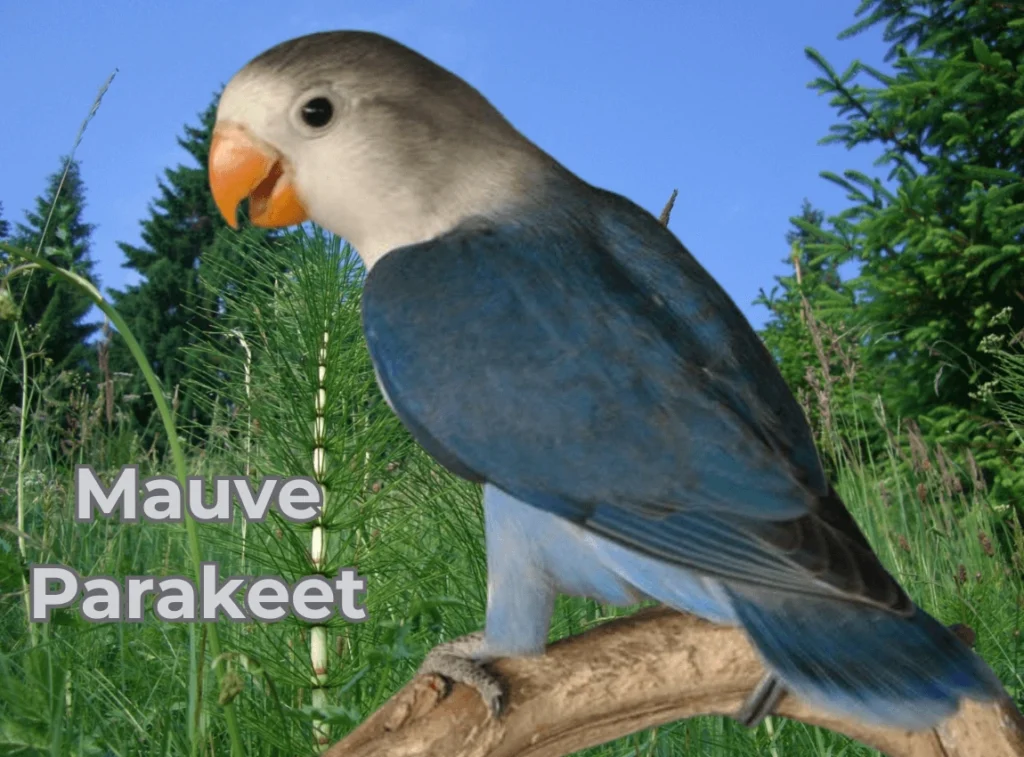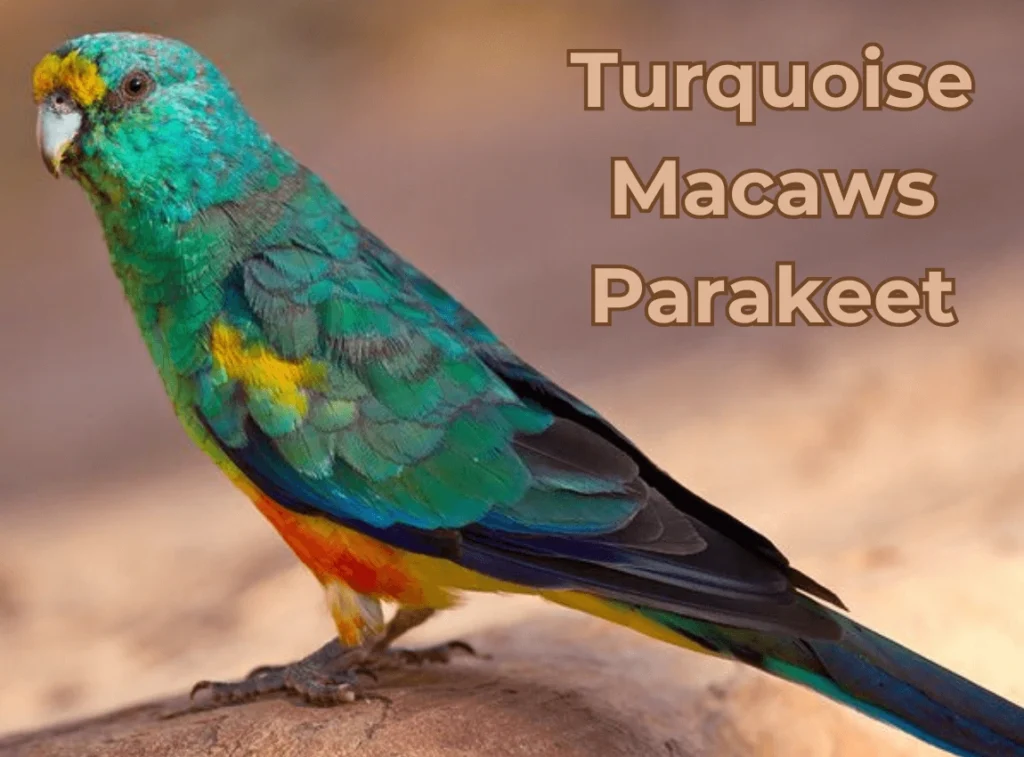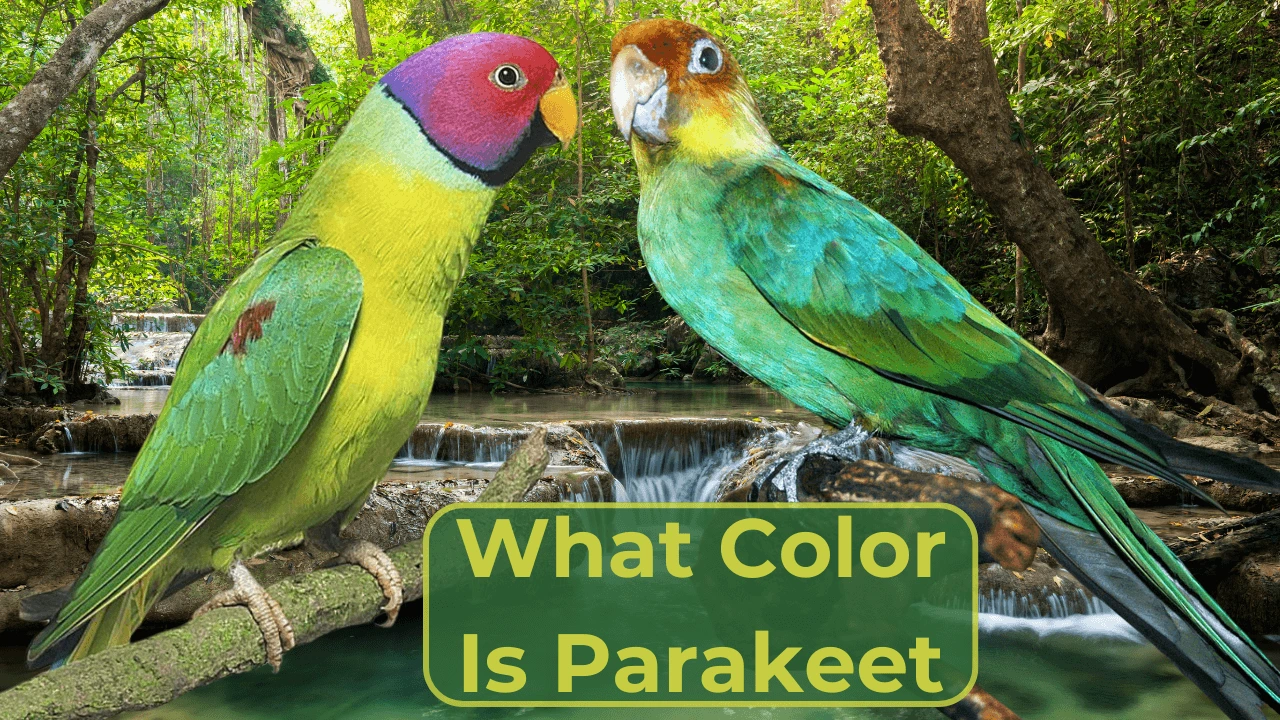Parakeets are one of the most popular and colorful pet birds in the world. From soft pastels to vibrant, vivid colors, their vibrant plumage is a joy to behold and a must-have for bird lovers. But what color is a parakeet have, and how do they get such vibrant colors?
Parakeets have a wide range of feather colors depending on a combination of genetics and mutations. What color is a parakeet in Australia. These are usually green with yellow and black patterns. However, selective breeding has led to an explosion of color variation and modern bird parakeets can be found in blue, yellow, white, purple, and even unusual shades like albino and turquoise.
Each color has its own unique appeal and knowing the different colors can help pet owners make informed choices. Feather color is not only aesthetically pleasing but also provides interesting insights into the genetics of these beautiful birds.

In this article, we’ll discuss the different colors of parakeets, how they change with breeding and the importance of these color variations in wild and captive parakeet populations. Whether you’re an experienced parakeet lover or a first-time parakeet owner learning about parakeet color is a fun way to deepen your understanding of these interesting and colorful birds.
- What Color is a Parakeet of Natural (In Wild):
- Most 15 Famous Color Types of Parakeet:
- 1. Green Parakeet:
- 2. Blue Parakeet:
- 3. Yellow (Lutino) Parakeet:
- 4. Albino Parakeet:
- 5. Violet Parakeet:
- 6. Grey Parakeet:
- 7. Olive Parakeet:
- 8. Mauve Parakeet:
- 9. Creamface Parakeet:
- 10. Spangle Parakeet:
- 11. Cinnamon Parakeet:
- 12. Opaline Parakeet:
- 13. Turquoise Macaws Parakeet:
- 14. Yellow face Parakeet:
- 15. Recessive Pied Parakeet:
- Key Differences of Male and Female Parakeet Beak Color:
- How Do Parakeet Colors Occur:
- Do Parakeet Colors Indicate Gender or Age:
- Rarest Color of Parakeet:
- Favorite Color of Parakeet:
- How to Maintain Vibrant Colors:
- Conclusion:
- Frequently Asked Question:
What Color is a Parakeet of Natural (In Wild):
Parakeets in captivity are naturally green. With their bright green bodies, black head paint colors and yellow wings, these parakeets blend in well with their natural habitat in the grasslands and forests of Australia. The green color of wild parakeets is the result of dominant pigmentation and provides excellent camouflage against predators. General characteristics of wild parakeets
- Body: bright green plumage.
- Head: yellow with black stripes.
- Wings and tail: black and green, tail feathers highlighted in blue.
This color combination of green and yellow is due to the specific pigments in parakeet feathers and the reflection of light a phenomenon that is common to many colors parakeet species.
Most 15 Famous Color Types of Parakeet:
Natural coloring and selective reproduction ensure a wide range of color variations. Each color variation has unique characteristics and is distinctive in both appearance and physical appearance. Below we highlight the 15 most well-known parakeet colors and their distinctive plumage and physical characteristics.
1. Green Parakeet:

The most common and natural species is the green parakeets which reflects the colors of parakeets found in the wild. The body is bright green. The snout is bright yellow and the wings have black edges. This coloring provides excellent camouflage in their natural habitat such as the grasslands of Australia. Green parakeets are playful and much appreciated by their owners. Their striking green coloring is a combination of yellow pigment and blue structural coloring that visually captures the beauty of nature.
2. Blue Parakeet:

Blue parakeets are a beautiful shade of blue ranging from light blue to deep cobalt blue and do not have the yellow pigmentation of green parakeets. The flanks are usually white and the wings have black edges which add to their striking appearance. This color variant is one of the most popular among parakeet lovers. Blue parakeets are known for their calm and friendly behavior making them ideal for families. Their unusual blue shade is often enhanced by bright lighting and proper care.
3. Yellow (Lutino) Parakeet:

Lutino parakeets are striking birds with bright yellow feathers and no green or black pigmentation. This variation combined with red and pink eyes, gives them a unique almost luminous appearance. Luciano parakeets are cheerful and energetic, and this is reflected in their cheerful coloration. Their wings are usually lightly spotted or not at all. This bird is popular for its striking beauty and is considered one of the rarest and most popular variants of the parakeet.
4. Albino Parakeet:

Albino parakeets are pure white parakeets that lack pigmentation due to a genetic mutation. Their feathers are pure white and their eyes are red or pink giving them an eye-catching and elegant appearance. These birds are rare and are often admired for their ethereal beauty. Albino birds are usually gentle and friendly making them ideal birds. However, due to their lack of pigmentation they need special care and protection from direct sunlight.
5. Violet Parakeet:

Purple parakeets are known for their bold rich purple and violet colors often mixed with shades of blue. This rare variant of the parakeet stands out with its vibrant plumage coloration. The face is usually white retaining the characteristic black wing bands. The violet parakeet is very active. Its color changes with the light becoming brighter in natural light. Due to its unique and attractive coloration this beautiful species is very popular among bird lovers.
6. Grey Parakeet:

Gray cockatoos range in color from light silver to dark charcoal. Their faces are usually white and their plumage is softly spotted giving them a sleek and understated look. The bird has a calm and elegant charm that sets it apart from brightly colored parakeets. Gray cockatoos are less common and are a special choice for bird lovers. Their soft neutral colors complement their vibrant nature and create a beautiful balance between delicacy and charm.
7. Olive Parakeet:

The olive-colored cockatoo has a dark green body with golden and pale yellow tones and a rich earthy color. This color is a change from the dark pigmentation of green cockatoos. Olive-colored parakeets have black stripes on their wings and their faces are often yellow which adds contrast to the overall appearance. These birds are lively and energetic and are popular with those looking for a natural but different color.
8. Mauve Parakeet:

Mauve (Lilac) parakeets are purplish gray giving them an elegant and noble appearance. The body is usually uniform lavender in color with a white face and thin black stripes on the wings. This unusual color variation is understated but attractive. Known for their gentle and friendly nature. Lavender-colored cockatiels are an excellent choice for owners who prefer a bird with subdued but equally beautiful colors.
9. Creamface Parakeet:

Budgies with cream or pale yellow lips have a coloration that contrasts with their blue, green or gray bodies. This variation is subtle and delicate adding a soft coloration to their overall appearance. Cream-mouthed budgies retain their wing fences and dark eyes which stand out against the lighter face tones. Their gentle behavior and distinctive coloring make them a favorite among budgie lovers looking for pastel shades.
10. Spangle Parakeet:

Scaled budgies have a unique wing pattern black slats are replaced by lighter colors creating a “scaled” effect. Depending on the variation. The coloration of the body can range from green and blue to yellow or white. These birds are visually striking and unique due to the very distinctive wing patterns. Scalloped parakeets are active and sociable and their distinctive markings often attract attention.
11. Cinnamon Parakeet:

Cinnamon parakeets have soft brown markings on their wings rather than the typical black coloration giving them a warm, soft look. Their body colors range from light green and blue to yellow. This variation gives the bird a more delicate and lighter appearance. Cinnamon parakeets are friendly and affectionate and often mingle with their owners. Their unique skin color adds to their charm and appeal.
12. Opaline Parakeet:

Opaline parakeets have a more uniform color distribution on the back and wings and fewer markings. This mutation results in smoother, more refined feathers. Their body color varies from green, blue and yellow. Active and energetic Parakeets are well-suited to interactive environments as they prefer active birds. Their soft colors increase their visual appeal making them popular with bird lovers.
13. Turquoise Macaws Parakeet:

Turquoise Macaws parakeet have a stunning turquoise body color similar to the gemstone from which they get their name. Their faces are usually white with black stripes on their wings that contrast with their shiny bodies. Turquoise macaws are known for their energetic and cheerful personalities. This rare and active mutation is very popular with hobbyists due to its impressive appearance.
14. Yellow face Parakeet:

Yellow-faced parakeets have a bright yellow face combined with a blue or purple body which creates an impressive contrast. This mutation often results in a color gradient effect where the yellow subtly blends into the body color. These birds also have black wing bands and black eyes. Yellow-faced parakeets are playful and energetic and their unique coloring will add a nice visual accent to any cage.
15. Recessive Pied Parakeet:

Recessive cherubs are known for their unique and peculiar patterns with large white or yellow patterns that blend into their base color. Their wings lack distinctive feathers and often have a solid-colored tail. These birds are so unique that no two cherubs are alike. They are a delight to be around due to their unique appearance and tendency to experiment with new ideas.
Key Differences of Male and Female Parakeet Beak Color:
The color of a parakeet’s beak can sometimes help to distinguish males from females. Despite this not always being the most accurate indicator. Here are the main differences in beak color by sex:
Male Parakeet Beak Color:
- Color: In general male parakeets have brighter and more pronounced beaks. Their beaks are often bright orange or reddish orange.
- Intensity: Male parakeets may have a more intense and vivid beak color especially during the breeding season.
- Shape: Male birds’ beaks are also more pronounced and slightly larger than those of females although this may not be noticeable.
Female Parakeet Beak Color:
- Color: Female parakeets tend to have a lighter, duller beak. Their beaks are often pale or light beige compared to the bright tones of males.
- Intensity: Females are generally less intense especially outside the breeding season.
- Figure: The beaks of females are slightly smaller and less pronounced than those of males.
Other Considerations:
- Species differences: In some parakeet species such as parakeets sex differences in beak color are more pronounced than in others.
- Age and breeding: The color of a parakeet’s beak can change depending on age, hormonal fluctuations and whether the bird is breeding. Males may have a lighter beak color during the breeding season.
- This is not always a clear indicator: Although beak color can be an indicator. It is not always a reliable way to determine the sex of a parakeet especially in species where males and females look the same.
How Do Parakeet Colors Occur:
The wide range of colors in parakeets is due to genetic mutations that affect pigmentation. Two primary pigments contribute to their coloration:
- Melanin: Dark tones such as black, grey and brown are produced by Melanin.
- Psittacofulvins: Responsible for light colors such as red, orange and yellow.
When light interacts with these pigments. It produces the bright green, blue and yellow colors seen in parakeets. Mutations can suppress or amplify these pigments resulting in the wide range of colors found in domestic parakeets.
An example:
- A mutation that suppresses yellow pigmentation results in blue parakeets.
- The absence of melanin and psittacofulvins results in albino or lutein parakeets.
Do Parakeet Colors Indicate Gender or Age:
The color of a parakeet’s body does not usually determine its sex but the cerebellum (the fleshy part above the beak) can be a clue:
- Males: have blue cerebellum as adults white or brown cerebellum as adults.
- Females: have cerebellum brown or white but may change during breeding season.
Parakeet coloration changes slightly with age. Young parakeets may have dull plumage which lightens as they mature. Older parakeets may also have slightly paler feathers.
Rarest Color of Parakeet:
The rarest color in parakeets is generally considered to be albino parakeets. Albino parakeets lack pigmentation giving them pure white feathers and striking red or pink eyes. This genetic mutation makes them very rare parakeets and highly sought after by bird lovers. Other rare colored parakeets include.
- Purple parakeets: known as deep purple or violet. This color is rarely seen in other parakeet species and is considered rare.
- Turquoise parakeets: With their shiny turquoise bodies turquoise parakeets are a rarely seen color but are highly prized for their bright appearance.
- Mauve parakeets: this color is a soft, delicate purple-gray that has a unique and elegant appearance but is relatively rare.
Favorite Color of Parakeet:
Like many other birds parakeets are attracted to bright, vibrant colors especially blue, green, yellow and red. However, it should be noted that the colors parakeets like can vary depending on personal preference. Parakeets generally perceive colors differently than humans as they are sensitive to certain wavelengths. For example Color preferences of parakeets
- Blue: Parakeets are known to be particularly attracted to the color blue which is why toys and accessories for parakeets are made in blue. Blue is a prominent color for parakeets and often their favorite color.
- Green: Parakeets are surrounded by green foliage in the wild and are naturally attracted to this color.
- Yellow: Bright yellow resembles sunlight is visually striking and can attract parakeets’ attention.
- Red: Red is not a dominant color but is attractive to parakeets especially when associated with food or toys.
How to Maintain Vibrant Colors:
If you notice a sudden change in the color or condition of your parakeet’s feathers, contact your vet.
- Balanced Diet: Provide a mix of seeds, pellets, fresh fruits, and vegetables.
- Regular Grooming: Ensure your parakeet gets water for bathing to keep its feathers clean.
- Healthy Environment: A clean, stress-free environment promotes healthy feather development.
Also Read: https://thepetlive.com/how-many-colors-of-parakeets-are-there/
Conclusion:
Parakeets come in a variety of colors each unique and attractive in its own way. From the classic green and blue to more unusual shades such as purple, turquoise and albino, parakeet colors are the result of natural color mutations and selective breeding. The most common color is green which is found in wild parakeets, while blue, yellow, and albino are very popular among bird lovers. Each coloration can have variations in tone, intensity, and shading that contribute to the overall appeal of these lively birds.
In addition to their vibrant plumage, parakeets have keen eyesight that allows them to see a wide range of colors which contributes to their attraction to bright vibrant environments. Whether you’re a parakeet hunter or just a hobbyist, the variety of colors these beautiful creatures parakeets come in adds to their appeal and makes them a colorful and interesting addition to any home.
Frequently Asked Question:
What is the rarest parakeet color?
The rarest parakeets are the albinos which have completely white feathers and red or pink eyes. Other rare colors are purple and turquoise parakeets.
What color are female parakeets?
Female parakeets can have different colors including green, blue and yellow. They usually have a lighter and paler back (the area above the beak) than males.
Are purple parakeets real?
Yes, there are purple parakeets especially purple parakeets. They have a unique combination of purple and blue feathers and are a rare but beautiful color variety.
What does a parakeet look like?
Parakeets are small colorful birds with a long tail and a variety of feather colors such as green, blue, yellow or purple. They have a slender, active build and bright plumage.
What is the most common parakeet color?
The most common color of parakeets is green. Parakeets in the wild have a unique color that is not found on their natural diet and are often found with domesticated parakeets.
What is the most beautiful parakeet?
Beauty is subjective but many consider purple or turquoise parakeets to be the most beautiful due to their unique and vibrant color.










